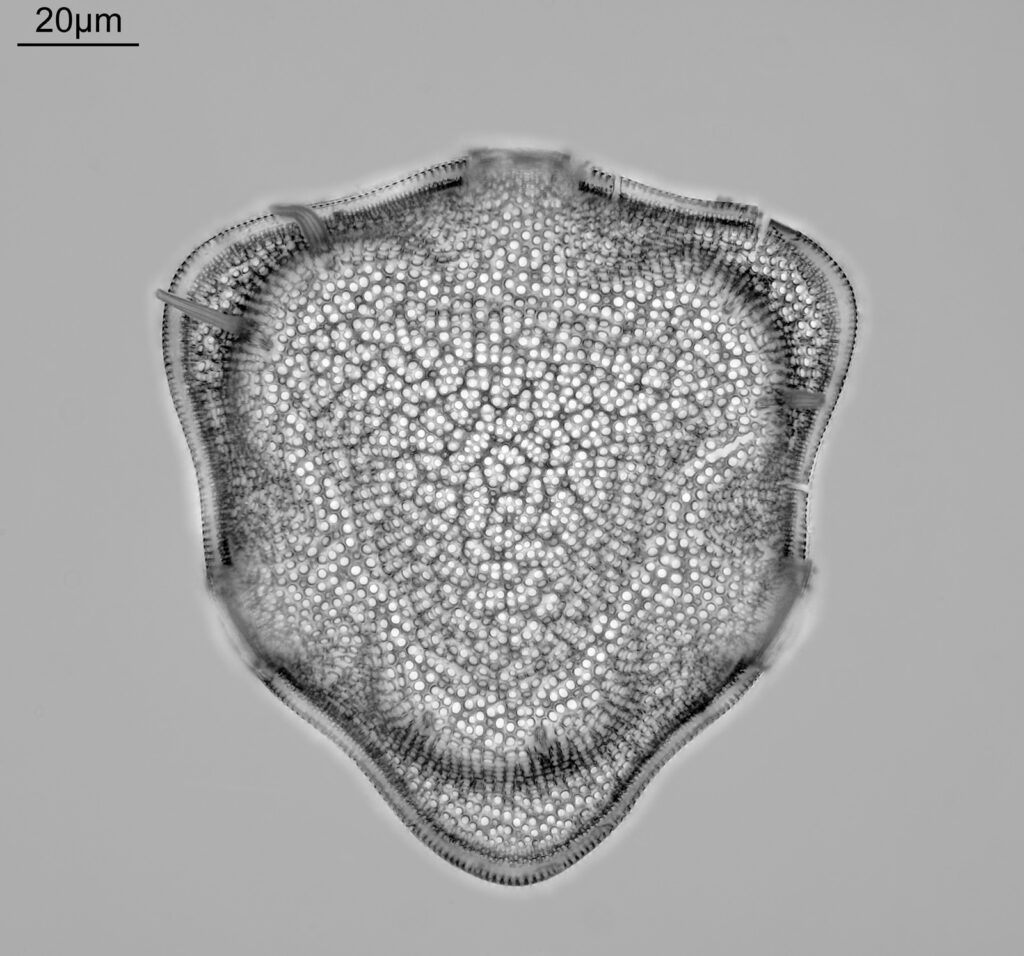Firstly, apologies for not posting a lot recently. My wife and I had a holiday in Tasmania in January, and I am still going through the photos from that (it’ll be done by the end of the month, fingers crossed). I have done a bit microscopy in my down time though, and it got me wondering, what would be my wish list for diatoms to image? I’m sharing some thoughts on this today, some of my wish list I have and others that I have yet to image. These images were done using my modified Olympus BHB microscope, and have been reduced in resolution for sharing here (the original are much higher resolution).
EDIT, 18th March 2024. I have managed to find an example of one of the diatoms am looking for – Truania archangelskiana – on a strew slide I had, so have included an image of that now.
I’m going to start with ones on the wish list that I have managed to find. Firstly one of the structurally prettiest diatoms I have imaged so far, Cerataulus subangulatus from the Oamaru deposit.

This was a slide made by Emiliano Bellotti and has a single example on slide. A beautiful structure as well as being a challenge to image.
Next we have Brightwellia Coronata, again from Oamaru.

This was on a strew slide from Allans Farm, Oamaru by Bernard Hartley, and is the most complete one I have found in the slides I have. It seems to be very prone to breakage, and finding a complete one is a ‘challenge’, although many Oamaru strew slides will contain fragments of them.
Next is Hydrosilicon mitra.

The slide maker here is JA Long, and the location is given as New Hebrides. It’s quite a rare diatom and extremely fragile. This one is the best I have with only a few broken ribs.
Next is Monopsia mammosa, another one from Oamaru.

Another slide by JA Long, and I do have second example of one which is more broken up. This has a couple of cracks, but that is about it.
This one I only imaged a few days ago – Actinoptychus affinis from Java.

This was a slide by Samuel H Meakin, and is almost complete apart from a bit of the edge missing. I love the patterning on this one.
Now for Triceratium nitescens on a slide by the maker RI Firth.

A beautifully shaped diatom from Barbados and one I was really happy to be able to image (the slide says ‘very rare’ and I believe that is true).
Now we get into ones that I am still actively looking for examples of, because I either only have a fragment of it, the one I have is not ideal for some reason, or ones which are so unusual I have only seen pictures of. To start with Charcotia decrescens from Antarctica.

This one is on a strew slide by Klaus Kemp, and is actually pretty good. I’m being picky here, it was at quite an angle in the strew, and made imaging difficult, so is one I keep an eye out for. I think it is also known as Chacotellia decrescens, and Actinocyclus actinochilus.
The next is one I only have a fragment of – Biddulphia pedalis from Oamaru.

Another slide by Samuel H Meakin, I have seen fragments of it, but so far have not tracked down a whole one and it seems to be quite a rare diatom. Also known as Grovea pedalis. Lovely details on it though. The image above was done using 365nm light and the short wavelength makes all the small features really pop.
The last one I do not have a individual sample of, but I have managed to find it on a strew slide by Bernard Hartley. It is Truania archangelskiana, and is shown below.

Reported locations for this one include Singiliewsky and Inza, Russia and Eidsbotn Fjord, Devon Island, Nunavut, Canada (seen here). An image of one can also be seen on the Photomacrography forum, here. A striking looking diatom and well worth looking out for for imaging.
I find imaging diatoms fascinating and rewarding, and never cease to be amazed by the varying forms. There are loads I could have listed here, but this gives a nice cross section of some of the more unusual ones. I hope you enjoy these images, and if you have any slides of these you would be open to finding a new home for, I can be reached here.
